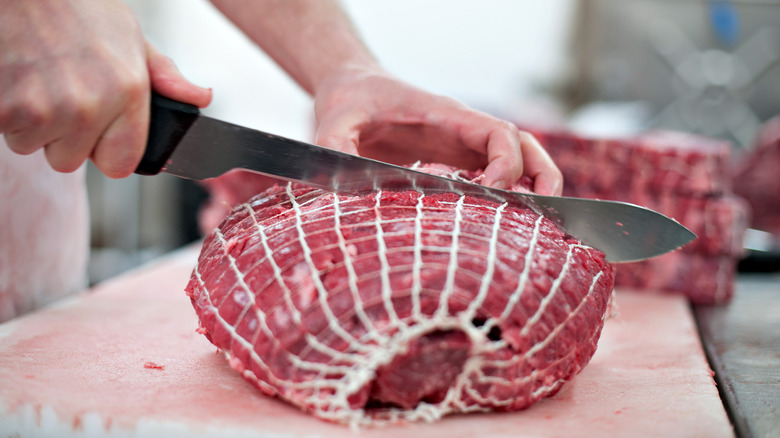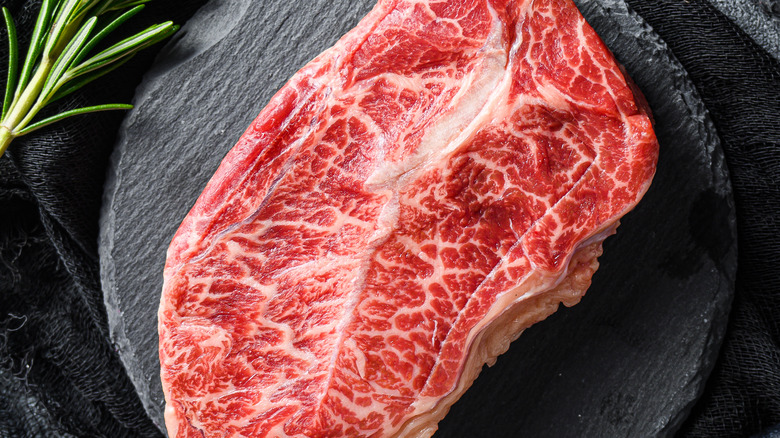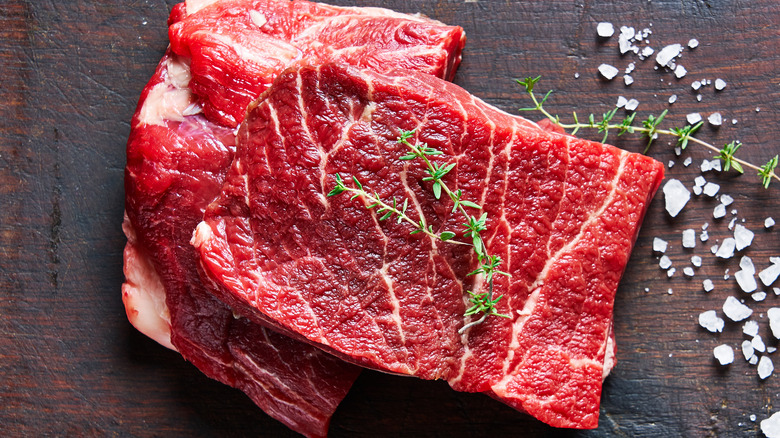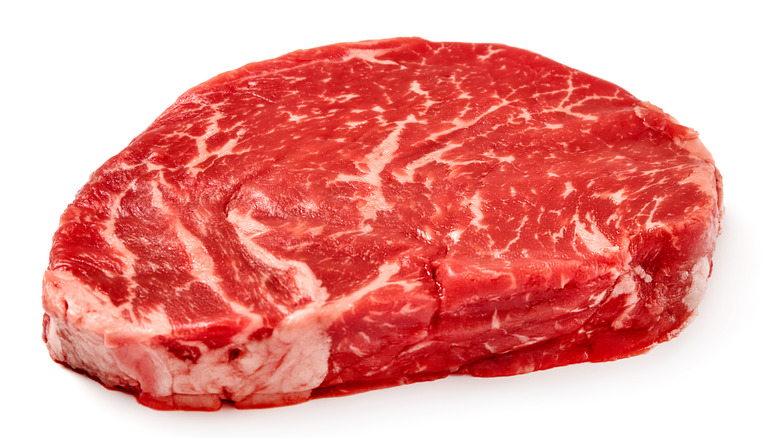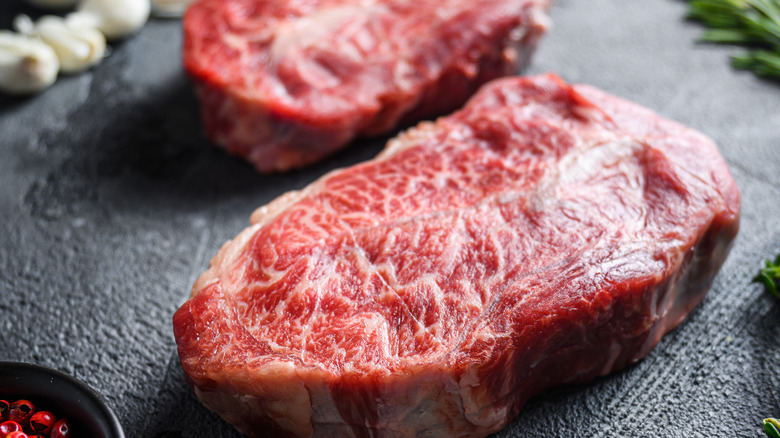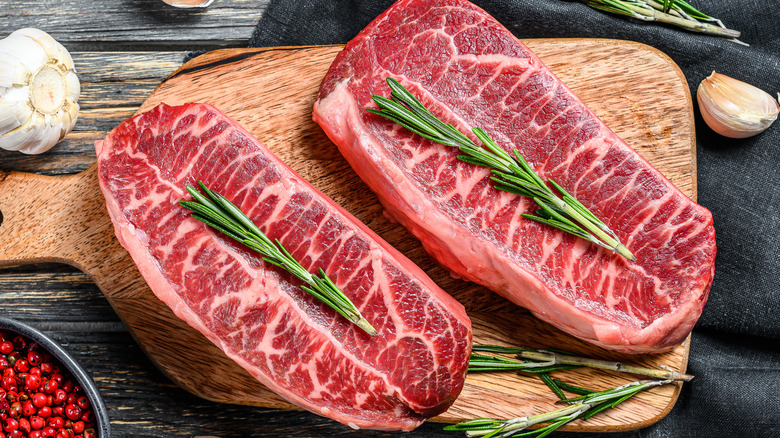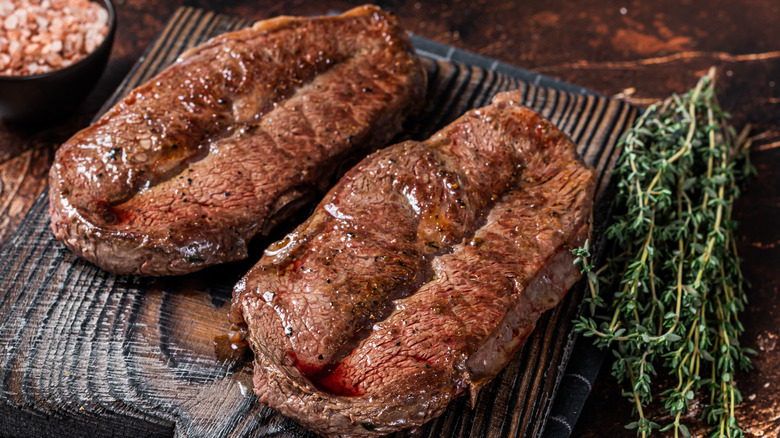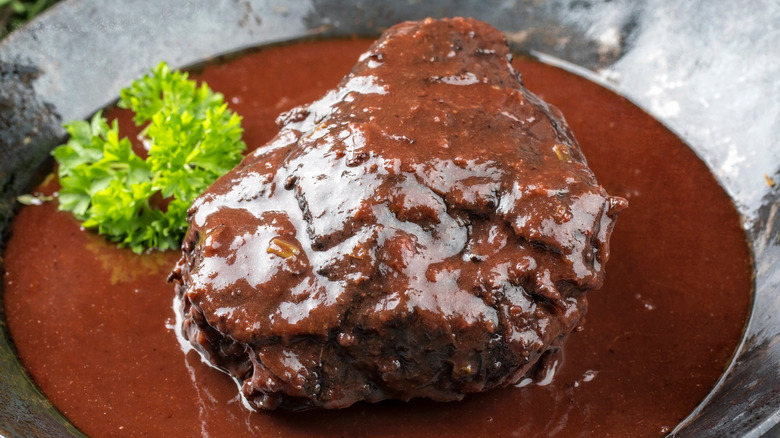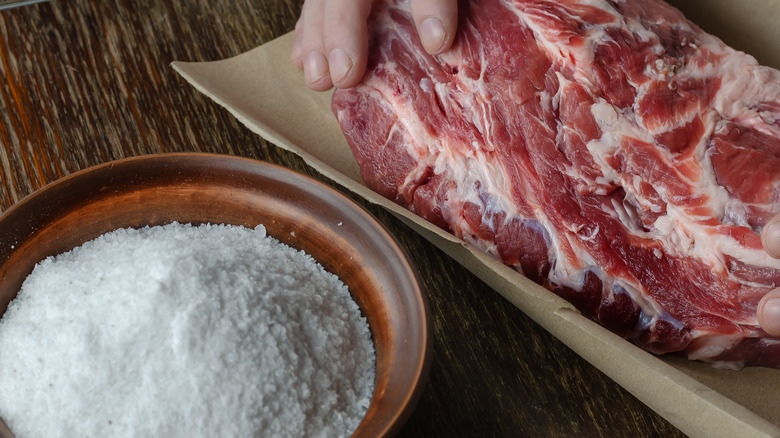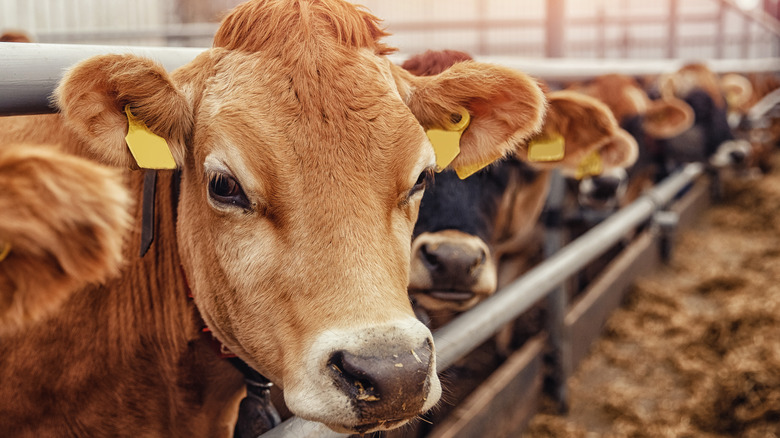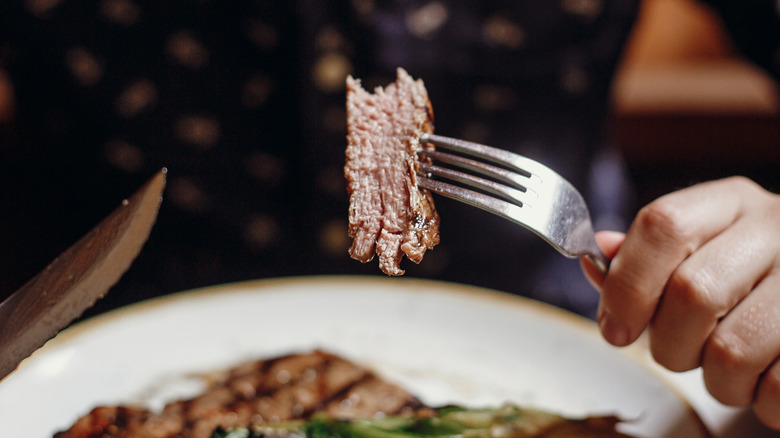What Is A Blade Steak And What Does It Taste Like?
From fancy dinners at special celebrations to common backyard cookouts, meat eaters consistently turn to steak as a favorite bite. But steak isn't a single food — it's an entire category. And even if you're familiar with the most common cuts found on restaurant menus and in your supermarket meat case, you're probably not an expert on every cut, or even aware of all of them. Whether you're searching for the best cuts of steak to grill this summer, the best cuts of steak for taco night tortilla stuffing, or even just the best cuts of steak for your budget, there are plenty of reasons to take a deeper dive into this diverse category.
Among the cuts of beef that are lesser known to the general masses, the blade steak is gaining in popularity with those who are already familiar with its merits. The rest of you may be hesitant to lay down the cash for a steak cut you haven't met, especially during times of scarcity and inflation. We totally understand that's a risk if you're unsure of how to cook it or how it will taste. But it turns out there are plenty of reasons to take a chance on this lesser known cut and few reasons to fear it. Here's everything you need to know about what a blade steak really is (and isn't), how to prepare it, and what it tastes likes.
It's a cut of chuck
In its most basic description, Avrom Farm sums up the blade steak most succinctly as a cut of beef that comes from the chuck region of the cow (more formally known as a primal in the butchering world and referring to the main regions initially separated from the carcass by the butcher before being cut into further pieces). It's a good start, but that brief description could be a bit misleading if you're already familiar with chuck, as almost anyone who's visited a supermarket meat department is.
As Beef. It's What's For Dinner explains, you'll often find cuts of chuck used for the roasts you imagine with potatoes and carrots — the hearty pot roasts perfect for cold winter nights with the family. But blade steak isn't one of those giant chunks of chuck ideal for a day of easy slow cooker recipes. Instead, it's a smaller cut from the shoulder blades, the top section of the chuck primal, and that has plenty of implications for preparation and taste that we'll dig further into below. So yes, it's part of the chuck, but it's hardly the chuck you're used to.
It goes by several other names
Before we carve our way through the nuances of blade steak, though, let's take a step back and clear up a few other points of confusion or misconception that may get in the way first. To begin with, blade steak goes by an annoyingly large variety of alternative names among various butchers across the United States. As Certified Angus Beef notes, you may have to try a number of names before tracking down a blade steak from your butcher. Blade stake also is known as book steak, breakfast steak, butler steak, and top boneless chuck steak.
Complicating matters further, blade steak masquerades under other names in other parts of the world, too. While it's not entirely uncommon to find foods that have different names in other countries, it certainly doesn't make it any easier to help understand what blade steak specifically is. Among the most potentially misleading of names for the blade steak found around the world, Hilltop Meats, an Australian beef company, says that Aussies call this cut the oyster blade steak. If you've ever heard of any of these cuts, then you may have already enjoyed blade steak and just didn't know it.
It's almost a flat iron steak, but it isn't
Adding to the potential confusion and misguidance, there's yet another name you may hear a blade steak called. But this one is entirely inaccurate, and that would be the flat iron steak. As The BBQ Brethren user UF Aero laments in the beefy forum, many people incorrectly use the names of blade steaks and flat iron steaks interchangeably because they not only both come from the chuck primal, but they also come from the same top region of the chuck. Though they do generally comprise the same meat, they're not the same product due to the distinct ways each one is cut.
We've already learned that blade steak comes from the top blade (shoulder) of the animal, but, as Omaha Steaks explains, there's a line of gristle present here that some just don't want to deal with. Additional butchery can remove that tough connective tissue to leave behind two flawless steaks. Those are known as flat iron steaks. So, while it is true that blade steak and flat iron steak are the same meat, flat iron steak has been further butchered to remove gristle. Of course, that also makes flat iron steaks a bit more expensive to purchase than blade steaks, and rightly so. They require an added step of professional precision.
It's a lower fat cut than other popular steaks
If we're being honest, we're aware that most people in search of delicious steak dinners aren't exactly on the health trail and seeking the most responsible meal for their wellness. Steak is a flavor choice that may either be a regular requirement or rare guilty pleasure for those who enjoy it, but few are showing up to the plate for its health benefits. Regardless, blade steak does actually come with some positive wellness news, whether sought after or not. At least as far as steaks are concerned.
According to Cathead's BBQ, because this chuck primal cut is worked so heavily by cattle as they move, there's little fat in this muscley region of beef, but the blade steak does actually contain some marbling from fat. What's the takeaway here? While most of the chuck is better used for roasts, as we've already explained, this bit of fat in the blade steak helps flavor it without introducing as much fat as would be found in other popular steak cuts, like the ribeye steak. SF Gate further adds that a 3-ounce serving of cooked blade steak contains only 3 grams of saturated fat out of 9 total grams of fat. If you do decide to watch the fat content of your steak, opting for a blade steak cuts back on the damage without completely sacrificing all of the flavor that comes with it.
It's really tender
Absolutely no true steak lover prefers tough meat, which is a major reason chefs and food industry pros say you should you never order your steak well done. But even without overcooking (or over-ordering), plenty of beef cuts are naturally tougher than others. That's the case for most meat from the chuck, which is why it's often cooked long and slow for roasts. Surprisingly, though, blade steaks are naturally extremely tender, as applauded by the Orlando Sentinel in its love letter to the tender cut. But how can this be?
Remember that horrible strip of connective tissue, also called sinew, that differentiates blade steak from flat iron steak when removed by alternative cutting? As Happy Valley Meat Co. explains, this seemingly annoying strip of sinew takes on most of the work when the animal is alive, leaving the surrounding steak unusually tender for the workhorse chuck region. While you may not appreciate the interruption of sinew down the center of your blade steaks, it is not that difficult to cut around, and you can thank it for leaving the rest of your bites so delightfully tender.
It's cheap
In the culinary world, it's rare that quality ingredients with enjoyable flavor are on the less expensive end of the cost spectrum, but blade steak is a rare exception. Taking a look at the most expensive cuts of steak, you'll never find blade steak anywhere near the list. Instead, as Kansas Beef explains, it's one of the best budget cuts of beef for lower cost meals that don't sacrifice quality or taste, and we personally consider it the No. 1 cheap steak you should buy.
Reddit user iridescent_algae, responding to a query in the steak subreddit, claims that blade steak is the best value for your money among all steak cuts, further adding that they've never encountered a single tough cut even though it's considerably less expensive than alternatives like flank steak. We've already learned that blade steak is cheaper than flat iron steak because of the strip of gristle it contains, but you don't really need to pay more to have it removed if you properly take it into account when preparing and cooking. The blade steak remains a great choice for a cheap cut.
It's not great for grilling
Okay, we know what you're thinking. One of the best ways to enjoy steak is hot off the grill with just the right amount of char, so why would anyone want a steak that is not ideal for grilling? We hear you, but don't write off the blade steak just yet. There's a good reason for this, and there are some workarounds if you really want some of that understandably coveted grill char. First, the facts. As sustainable Canadian meat farm Two Calves Standing reminds us, that pesky strip of sinew running through the blade steak is tough on the jaw already, and cooking at high heat on a grill only makes this connective tissue even more impossible to eat.
The rest of the meat is unusually tender, though, so you may still be determined to grill this bad boy. It can be done, as YouTuber Asianadian demonstrates. You'll just need to cook it as quickly as possible, so the rarer your preference falls on the doneness scale, the better your chances will be of grilling a blade steak without ruining it. To be fair, the same is true of any cut of steak. You're still going to have to cut around the sinew, though. If you want some of that char without grilling your blade steak to death, you can also simply sear the edges on the stovetop (a cast iron pan or griddle will work well for this) before cooking another way.
It should be braised
So what are those other cooking methods that are better suited for the blade steak? There are a couple of options, and they all involve long, slow cooking, but we're not throwing it in the crock pot with a bunch of veggies for a roast. It's still a steak after all. Professional Secrets may describe blade steak lumped together with the rest of the chuck meat, which leads the site to suggest methods like boiling. You certainly can do this for a tasty stew, but you already know better than this. Blade steak is a cut above stew beef (regular chuck), so don't waste it.
For the best outcome with blade steak, follow the sage advice of TheMeatSource and braise this beef. You can definitely do this in a crock pot or Dutch oven, in which case it may certainly seem like you're about to make a stew or pot roast, but it's accomplished just as well on the stovetop with a tight-fitting lid, and you won't be adding veggies or other sides to the pan for a one-pot wonder meal. The goal is simply slow cooking at lower heat to tenderize the meat without over-toughening that pesky strip of sinew and its immediate surroundings. TheMeatSource also recommends marinating first, and this can help as a second method to tenderize the meat, but be careful not to overdo it if you want to marinate your meat perfectly; otherwise, you could cause more damage than deliciousness.
It could be cured
This one's not a cooking method, but there's yet another way to maximize the tenderness of the blade steak, and that's through curing. At its core, the act of curing describes the process of completely drawing out moisture from the meat (per Webstaurant Store). It's not a difficult process, which is why people have been doing it for centuries. Historically, this was a necessity implemented for longer-term food preservation, way before the invention of refrigeration, but it also has the joyous benefit of tenderizing meat. The especially good news is you only need salt and time to accomplish this.
As described on the AskCulinary subreddit, dry brining (which is another term for this form of curing) can be accomplished as easily as covering steaks in salt and refrigerating them for a couple of hours. While others salt-cure their steaks in the oven overnight, The National Center for Home Food Preservation advises against keeping beef at room temperature for this process, as it can introduce the danger of harmful bacterial growth, so stick with the fridge method for maximum safety. And don't be stingy with the salt.
It tastes especially beefy
Blade steak clearly has plenty of benefits, ranging from cost to tenderness, but we would agree that those are still only relevant if it actually has a worthwhile taste, so we'll attempt to explain that critical quality to you now. While you have heard the groanworthy and completely useless assessment that so many novel bites taste like chicken, blade steak most definitely does not. In fact, the most common descriptor you'll find for blade steak is that it tastes especially beefy. This is precisely how Carnivore Style describes blade steak, attributing that rich and creamy taste to the marbling found throughout the cut. But is it fair to describe beef as tasting beefy? We're sure you might be wondering exactly what that means, so we dug a little deeper into this one.
According to the Los Angeles Times, the flavor of beef is best described as the element we identify as savory, and it is not only easily detectable but can be attributed to a single molecule discovered in the 1990s. It's actually so recognizable and loved that the food industry was instantly interested in recreating it to flavor other bites, like vegetarian and vegan foods or even cuts of beef with less natural beef flavor. Fortunately, blade steak is bursting with natural beef flavor, so there's no need to add anything to this cut.
Its strong flavor stands out
Okay, so we can now accept that blade steak has a recognizably beefy flavor, but you still may be wondering how strong the flavor is. Is it like wine, where you may detect subtle notes of this or that? Definitely not. As Lake Geneva Country Meats explains, the blade steak has quite the "rich flavor," and the rest of the meat from the chuck primal does, too. This means that if you want to use the marinade method mentioned above to tenderize your meat and add some additional flavors to your finished plate, you can do so without worrying that you'll overpower that prized beefy flavor.
As HuffPost details, there are several ways to mess up your meat with improper marinating, and some of them lead to destroying the flavor instead of enhancing it. Those many mishaps can include anything from adding too much salt to using the wrong ratio of acid to fat. (And if learning that adding too much salt could ruin your marinade makes you wonder whether salt curing is equally dangerous, fear not. They're not the same process, and they don't have the same outcome.) The good news with blade steak is that its super strong natural flavor makes it a bit harder to overpower with an amateur marinade, so you won't have to stress quite as much. You can just relax and enjoy your blade steak.

